|
Egyptian head |
 |
Phoenician aleph |
 |
Greek alpha |
Α (α) |
|
In
Gardiner's sign list this is E2,
aggressive bull. |
|
Egyptian house |
 |
Phoenician beth |
 |
Greek beta |
Β (β) |
|
... Like the
names of most other Greek letters, the
name of beta was adopted from the
acrophonic name of the corresponding
letter in Phoenician, which was the
common Semitic word *bayt
('house').
In the system of Greek
numerals beta had a value of 2.
... 'The traditions show that the
residences of the king were fairly
flexible. The building of new houses was
obviously the result of (male) births in
the royal family. In each case, the
house that was built last is left to the
newborn son and his mother, together
with a specific servant, while the king
has a new and separate residence
constructed for himself
...
 |
|
Throwing stick? |
 |
Phoenician
gimel |
 |
Greek gamma |
Γ (γ) |
|
... In its unattested
Proto-Canaanite form, the letter
[gimel] may have been
named after a weapon that was
either a staff sling or a
throwing stick, ultimately
deriving from a Proto-Sinaitic
glyph ... Bertrand Russell
posits that the letter's form is
a conventionalized image of a
camel. The letter may be the
shape of the walking animal's
head, neck, and forelegs [cfr
the way Taurus normally is
depicted]. Barry B. Powell, a
specialist in the history of
writing, states 'It is hard to
imagine how gimel
= 'camel' can be derived from
the picture of a camel ... The
word gimel is related to
gemul, which means
'justified repayment', or the
giving of reward and punishment.
The Swedish word gammal
means 'old' (and dry like a
stick).

... Tu'i Tofua
was the son of Vakafuhu.
His mother was Langitaetaea,
but she was only one of the many
young women whom Vakafuhu
had living behind the fences of
his dwelling. When Tu'i Tofua
grew he was given the first-born
sons of all the wives for his
companions, and they all used to
play sika outside the
enclosure of Vakafuhu.
They made their sika of
clean-peeled sticks and threw
them in turn
along the ground,
they glanced them off a mound
and each one tried to make the
longest throw.
One day while
Vakafuhu was sleeping off
a kava-drinking those boys were
playing their game outside, and
Tu'i Tofua threw his
sika. Then indeed the
enormous strength of Tu'i
Tofua made that sika
fly over the fences into his
father's place.
It landed
where the women were and they
all began to giggle, those
girls, and shriek and laugh.
They did this because they
wanted that handsome youth to
come among them, they desired
him. More than his father they
desired him. They fell with joy
upon the sika of their
master's son, and snapped it.
When he came inside to get it
back they called out things that
made him embarrased. 'Haven't
you got another long thing
there, Tu'i?' those women
said. 'This one's broken.' And
they put their hands across
their faces and they laughed
... |
|
Egyptian
door |
 |
Phoenician
dalet |
 |
Greek
delta |
Δ (δ) |
...
Delta (uppercase Δ, lowercase
δ) ... is the fourth letter of the
Greek alphabet. In the system of
Greek numerals it has a value of 4.
It was derived from the Phoenician
letter Dalet.
Letters that come from delta include
Latin D and Cyrillic Д. A river
delta (originally, the Nile River
delta) is so named because its shape
approximates the upper-case letter
delta (the shape is a triangle) ...
Dalet (dāleth,
also spelled Daleth or
Daled) is the fourth letter of
many Semitic alphabets ... The
letter is based on a glyph of the
Middle Bronze Age alphabets,
probably called dalt 'door'
(door in Modern Hebrew is delet),
ultimately based on a hieroglyph
depicting a door.

... Sorrowing, then,
the two women placed Osiris's coffer
on a boat, and when the goddess Isis
was alone with it at sea, she opened
the chest and, laying her face on
the face of her brother, kissed him
and wept. The myth goes on to tell
of the blessed boat's arrival in the
marshes of the Delta, and of how
Set, one night hunting the boar by
the light of the full moon,
discovered the sarcophagus and tore
the body into fourteen pieces, which
he scattered abroad; so that, once
again, the goddess had a difficult
task before her. She was assisted,
this time, however, by her little
son Horus, who had the head of a
hawk, by the son of her sister
Nephtys, little Anubis, who had the
head of a jackal, and by Nephtys
herself, the sister-bride of their
wicked brother Set. Anubis, the
elder of the two boys, had been
conceived one very dark night, we
are told, when Osiris mistook
Nephtys for Isis; so that by some it
is argued that the malice of Set
must have been inspired not by the
public virtue and good name of the
noble culture hero, but by this
domestic inadventure. The younger,
but true son, Horus, on the other
hand, had been more fortunately
conceived - according to some, when
Isis lay upon her dead brother in
the boat, or, according to others,
as she fluttered about the palace
pillar in the form of a bird.
The four bereaved and
searching divinities, the two
mothers and their two sons, were
joined by a fifth, the moon-god
Thoth (who appears sometimes in the
form of an ibis-headed scribe, at
other times in the form of a
baboon), and together they found all
of Osiris save his genital member,
which had been swallowed by a fish.
They tightly swathed the broken body
in linen bandages, and when they
performed over it the rites that
thereafter were to be continued in
Egypt in the ceremonial burial of
kings, Isis fanned the corpse with
her wings and Osiris revived, to
become the ruler of the dead. He now
sits majestically in the underworld,
in the Hall of the Two Truths,
assisted by forty-two assessors, one
from each of the principal districts
of Egypt; and there he judges the
souls of the dead. These confess
before him, and when their hearts
have been weighed in a balance
against a feather, receive,
according to their lives, the reward
of virtue and the punishment of sin
...
|
|
Egyptian jubilation |
 |
Phoenician
he |
 |
Greek
epsilon |
Ε (ε) |
|
Wikipedia
points at the Egyptian gesture with arms
held high as a Sign of jubilation, which
may have been the origin (via Phoenician
he) of epsilon.

 |
|
Manacle |
ziqq |
Phoenician zayin |
 |
Greek zeta |
Ζ (ζ) |
|
... Zeta (uppercase
Ζ,
lowercase
ζ;
Greek:
ζήτα
... is the sixth letter of the Greek
alphabet. In the system of Greek
numerals, it has a value of 7. It was
derived from the Phoenician letter
Zayin. Letters that arose from zeta
include the Roman Z and Cyrillic
З
...
Zayin
(also spelled Zain or Zayn
or simply Zay) is the seventh
letter of many Semitic abjads ... It
represents the sound
[z]. The Phoenician letter
appears to be named after a sword or
other weapon. (In Biblical Hebrew, 'Zayin'
means sword, and the verb 'Lezayen'
means to arm. In modern Hebrew, 'zayin'
means penis and 'lezayen' is a
vulgar term which generally means to
perform sexual intercourse and is used
in a similar fashion to the English word
fuck, although the older meaning
survives in 'maavak mezuyan'
(armed struggle) and 'beton
mezuyan' (armed, i.e., reinforced
concrete). The Proto-Sinaitic glyph
according to Brian Colless may have been
called ziqq, based on a
hieroglyph depicting a 'manacle'.

 |
|
Egyptian eye |
 |
Phoenician ayin |
 |
Greek omicron |
Ο (ο) |
|
... The
letter name is derived from
Proto-Semitic
*‘ayn-,
eye, and the Phoenician letter had an
eye-shape, ultimately derived from the
jr hieroglyph ... To this day,
‘ayin in Hebrew,
Arabic and Maltese means 'eye' and
'spring' (‘ayno
in Neo-Aramaic).
 |
|
Greek omega |
Ω (ω) |
|
Omega
... is the 24th and last letter of
the Greek alphabet. In the Greek numeric
system, it has a value of 800. The word
literally means 'great O' (ō mega, mega
meaning 'great'), as opposed to omicron,
which means 'little O' (o mikron, micron
meaning 'little') ...
The form of the uppercase
letter derives from that of an omicron
(Ο) broken up at the side ... with the
edges subsequently turned outward

The
modern lowercase shape goes back to the
uncial form

a form that developed
during the 3rd century BC in ancient
handwriting on papyrus, from a
flattened-out form of the letter ...
that had its edges curved even further
upward

Possibly, I think, this flattened out
form alluded to the high sky 'carapace' in summer. As to the
'broken up omikron' it could have been turned at is side as an allusion to the orientation of the Gemini pair.
The uncial form could reflect a pair of
twins joined together (at the star
ω Gemini).
 |
|
Egyptian courtyard |
 |
Phoenician heth |
 |
Greek eta |
Η (η) |
|
... The
letter shape ultimately goes back to a
hieroglyph for 'courtyard' ... possibly
named
hasir in the Middle Bronze Age
alphabets, while the name goes rather
back to
hayt, the name reconstructed for
a letter derived from a hieroglyph for
'thread'

... The kaikai are the rythmic
songs that are sung to cat's cradles,
the string games that are found not only
throughout the Pacific but throughout
the world. On premissionary Rapa Nui
the kaikai, together with their
corresponding cat's cradles, were not
simple children's games but were used,
among other things, to produce magic
effect. They were highly important for
the study of Rapa Nui's
rongorongo. This is because it was
apparently with the aid of cat's cradles
that the rongorongo experts taught their
pupils to learn many of the chants
accompanying the incised inscriptions
...
... string games could be resumed after
it was clear that the Sun had managed to
leave the horizon and was rapidly
gaining in altitude: 'Before the sun
starts to leave the horizon ... when it
shows only on the horizon, ... then
string games were no longer allowed as
they might lacerate the sun. Once the
sun had started to go higher and could
be seen in its entirety, string games
could be resumed, if one so wished. So
the restriction on playing string games
was only applicable during the period
between the sun's return and its rising
fully above the horizon
...
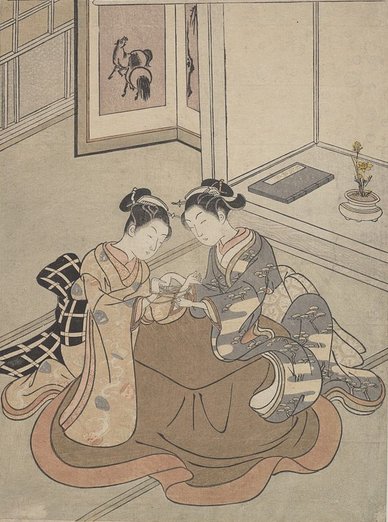
 |
|
Egyptian arm |
 |
Phoenician
yodh |
 |
Greek iota |
Ι (ι) |
|
Yodh
is thought to have originated with a
pictograph of a hand, ultimately
deriving from Proto-Semitic *yad-.
It may be related to the Egyptian
hieroglyphic of an arm. (Wikipedia)
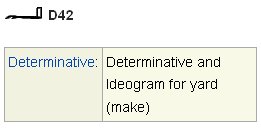 |
|
Egyptian hand |
 |
Phoenician kaph |
 |
Greek
kappa |
Κ (κ) |
|
Kaph is
thought to have
been derived
from a pictogram
of a hand (in
both modern
Arabic and
modern Hebrew,
kaph
means palm/grip)
...
... The manik,
with the tzab,
or serpent's
rattles as
prefix, runs
across Madrid
tz. 22 , the
figures in the
pictures all
holding the
rattle; it runs
across the
hunting scenes
of Madrid tz.
61, 62, and
finally appears
in all four
clauses of tz.
175, the
so-called
'baptism'
tzolkin. It
seems
impossible, with
all this, to
avoid assigning
the value of
grasping or
receiving. But
in the final
confirmation, we
have the direct
evidence of the
signs for East
and West. For
the East we have
the glyph
Ahau-Kin,
the Lord Sun,
the Lord of Day;
for the West we
have
Manik-Kin,
exactly
corresponding to
the term
Chikin, the
biting or eating
of the Sun,
seizing it in
the mouth.



The pictures
(from Gates)
show east,
north, west, and
south;
respectively
(the lower two
glyphs) 'Lord'
(Ahau)
and 'grasp' (Manik).
Manik was
the 7th day sign
of the 20 and
Ahau the
last
... |
|
Egyptian
menchet |
 |
Phoenician
lamedh |
 |
Greek
lambda |
Λ (λ) |
|
...
Wikipedia has no information regarding
the origin of the Phoenician lamedh,
but the Egyptian 'cloth' hieroglyph (menchet)
is - I suggest - related to the 4 upside
down sky pillars. I.e. the basic element
of the 'covering' hieroglyph could have
indicated darkness:


... Men's spirits were thought to dwell
in the Milky Way between incarnations.
This conception has been handed down as
an Orphic and Pythagorean tradition
fitting into the frame of the migration
of the soul. Macrobius, who has provided
the broadest report on the matter, has
it that souls ascend by way of
Capricorn, and then, in order to be
reborn, descend again through the 'Gate
of Cancer'. Macrobius talks of signs;
the constellations rising at the
solstices in his time (and still in
ours) were Gemini and Sagittarius: the
'Gate of Cancer' means Gemini
...
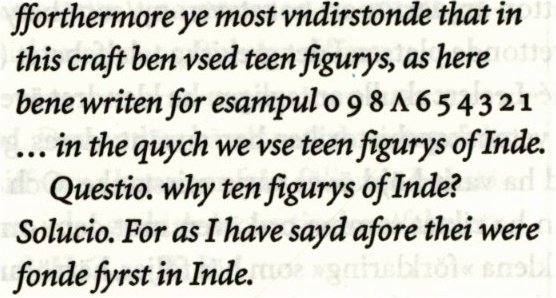

From the year 755 (when Cancer had been
at July 11 according to the Mayas) to AD
1842 (my assumed baseline for the
rongorongo texts) there were around
(1842 - 755) / 71 = 15 precessional
days. This seems to point to the time of
the Bull, when in JANUARY 31 the old
year would end (terminate). 192 (JULY
11) - 31 = 161 (JUNE 10):
...
Midsummer is the flowering season of the
oak, which is the tree of endurance and
triumph, and like the ash is said to
'court the lightning flash'. Its roots
are believed to extend as deep
underground as its branches rise in the
air - Virgil mentions this - which makes
it emblematic of a god whose law runs
both in Heaven and in the Underworld ...
The month, which takes its name from
Juppiter the oak-god, begins on June
10th and ends of July 7th. Midway
comes St. John's Day, June 24th, the day
on which the oak-king was sacrificially
burned alive. The Celtic year was
divided into two halves with the second
half beginning in July, apparently after
a seven-day wake, or funeral feast, in
the oak-king's honour
...
... The Fijian barkcloth that in the end captures the chief represents his capture of the land: upon installation, he is said to hold the 'barkcloth of the land' (masi ni vanua). The barkcloth thus has deeper significance. In general ritual usage, barkcloth serves as 'the path of the god'. Hanging from the rafters at the rear, sacred end of the ancient temple, it is the avenue by which the god descends to enter the priest ... There is still more to the barkcloth. The barkcloth which provides access for the god/chief and signifies his sovereignity is the preeminent feminine valuable (i yau) in Fiji. It is the highest product of woman's labor, and as such a principal good of ceremonial exchange (soolevu). The chief's accession is mediated by the object that saliently signifies women ... |
|
Egyptian sebchet |
 |
Phoenician
pe |
 |
Greek
pi |
Π (π) |
|
Wikipedia: '... according to a theory by
Theodor Nöldeke from 1904, some of the
letter names were changed in Phoenician
from the Proto-Canaanite script ...
pit
'corner' to pe 'mouth' ...'
However, I
think the Egyptian source hieroglyph
could have been Gardiner's O14 (sebchet),
a sign which illustrates a corner
with feather-like ornaments upon the
walls. The meaning was 'portal'
according to Wilkinson. Or why not
an Archway for exit, the Mayas had a
'grasping hand' (Chikin) in
the west:
To be in a corner
means there is no way forward.
|
| Egyptian tusk |
 |
Phoenician shin |
 |
Greek sigma |
Σ (σ, ς) |
|
Wikipedia: Shin (also spelled Šin (šīn) or Sheen) literally means 'teeth, 'press', and 'sharp' ...
The symbol Σ is currently used as an expression for 'sum'. The Phoenician shin is oriented in another way, similar to how Cassiopeia is read in the night when in a low position - as Celestial W when below the pole, in contrast to the Celestial M when above it.
Greek sigma therefore resembles Cassiopeia in between, when she was in the west at the time when the Sun was rising in the east. 
|
|
Egyptian
nfr |
 |
Phoenician
teth |
 |
Greek
theta |
Θ (θ) |
|
... The form of the
letter
θ
suggests a midline ('waist'), although
the origin of θ is the Phoenician
tēth which means 'wheel'. This in
turn could have originated from a glyph
named 'good' which in Egypt was nfr
...
... θ is the last star in the Ara
constellation, and the ancient meaning
of this letter was described as a wheel
by the Phoenicians but for the Egyptian
it meant 'good'.
When the wheel of time has come full
cycle around and the upside down
fire-altar is in the past the times
ahead should be good (or lucky Sa'ad)
...
According to Wilkinson
nefer
originally depicted the throat and heart
of a sheep:

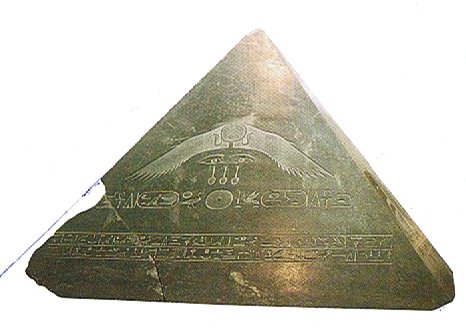 |
|
Egyptian bread, (-t, female
determinant) |
 |
Phoenician qoph |
 |
Greek
phi |
Φ(φ) |
|
... is
the 21st letter of the Greek alphabet
... Its origin is uncertain but it may
be that phi originated as the letter
qoppa ... In traditional Greek numerals,
phi has a value of 500 or 500000 ...
Isaac Taylor, History
of the Alphabet: Semitic Alphabets, Part
1, 2003: 'The old explanation, which
has again been revived by Halévy, is
that it denotes an 'ape,' the character
Q being taken to represent an ape
with its tail hanging down. It may also
be referred to a Talmudic root which
would signify an 'aperture' of some
kind, as the 'eye of a needle,' ...
Lenormant adopts the more usual
explanation that the word means a 'knot'
...

... The king, wearing now a short, stiff
archaic mantle, walks in a grave and
stately manner to the sanctuary of the
wolf-god Upwaut, the 'Opener of
the Way', where he anoints the sacred
standard and, preceded by this, marches
to the palace chapel, into which he
disappears. A period of time elapses
during which the pharaoh is no longer
manifest.

When he reappears he is clothed as in
the Narmer palette, wearing the kilt
with Hathor belt and bull's tail
attatched. In his right hand he holds
the flail scepter and in his left,
instead of the usual crook of the Good
Shepherd, an object resembling a small
scroll, called the Will, the House
Document, or Secret of the Two Partners,
which he exhibits in triumph,
proclaiming to all in attendance that it
was given him by his dead father
Osiris, in the presence of the
earth-god Geb. 'I have run', he
cries, 'holding the Secret of the Two
Partners, the Will that my father has
given me before Geb. I have
passed through the land and touched the
four sides of it. I traverse it as I
desire.' ...
.jpg) |
|
Egyptian flail |
 |
Phoenician lamed |
 |
Greek
psi |
Ψ (ψ) |
|
Wikipedia: In writing, the early letter
appears in an angular shape ( ).
There were early graphical variants that
omitted the stem, 'chickenfoot-shaped
psi', as: ).
There were early graphical variants that
omitted the stem, 'chickenfoot-shaped
psi', as:
 or
or

In later
research it was postulated that the
[Phoenician] alphabet is actually two
complete lists, the first dealing with
land agriculture and activity, and the
second dealing with water, sea and
fishing.
The first half beginning
with Alef - an ox, and ending with
Lamed
- a whip. The second list begins with
Mem - water, and continues with
Nun -
fish, Samek - fish bones, Ayin - a water
spring, Peh - the mouth of a well,
Tsadi
- to fish, Kof, Resh and
Shin are the
hook hole, hook head and hook teeth,
known to exist from prehistoric times,
and the Tav is the mark used to count
the fish caught.
The Crook and Flail were
instruments of the Pharaoh:
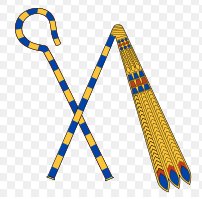 |
|
Egyptian water ripples |
 |
Phoenician
mēm |
 |
Greek
mu |
Μ (μ) |
... Behind me, towering almost 100 feet into the
air, was a perfect ziggurat, the Temple of
Kukulkan.
Its four stairways had 91 steps
each. Taken together with the top
platform, which counted as a further
step, the total was 365. This gave
the number of complete days in a
solar year. In addition, the
geometric design and orientation of
the ancient structure had been
calibrated with Swiss-watch
precision to achieve an objective as
dramatic as it was esoteric: on the
spring and autumn equinoxes, regular
as clockwork, triangular patterns of
light and shadow combined to create
the illusion of a giant serpent
undulating on the northern staircase
...
|
|
Egyptian cobra in repose |
 |
Phoenician nūn |
 |
Greek
nu |
Ν (ν) |
|
...
Nun is thought to have come from a
pictogram of a snake (the Hebrew word
for snake, nachash begins with a
Nun and snake in Aramaic is
nun) or eel.
Some have
hypothesized a hieroglyph of a fish in
water for its origin (in Arabic,
nūn means large fish or
whale). The Phoenician letter was named
nūn 'fish', but the glyph has
been suggested to descend from a
hypothetical Proto-Canaanite
nahš 'snake', based on the
name in Ethiopic, ultimately from a
hieroglyph representing a snake.
... Nahš in modern Arabic
literally means 'bad luck'. The cognate
letter in Ge'ez and descended Semitic
languages of Ethiopia is nehas,
which also means 'brass'. |
|
Egyptian sky pillar |
 |
Phoenician waw |
 |
Greek
upsilon |
Υ(υ) |
|
...
Upsilon (uppercase Υ, lowercase υ;
Greek: ύψιλον, ýpsilon ... is the 20th
letter of the Greek alphabet. In the
system of Greek numerals, Υ has a value
of 400. It is derived from the
Phoenician waw ... Waw (wāw
'hook') is the sixth letter of the
Semitic abjads ...
... Upsilon is known as
Pythagoras' letter, or the Samian
letter, because Pythagoras used it as an
emblem of the path of virtue or vice. As
the Roman writer Persius wrote in
Satire III:
and the letter which spreads out into
Pythagorean branches has pointed out to
you the steep path which rises on the
right.
Lactantius, an early Christian author
(ca. 240 - ca. 320), refers to this:
For they say that the course of human
life resembles the letter Y, because
every one of men, when he has reached
the threshold of early youth, and has
arrived at the place 'where the way
divides itself into two parts', is in
doubt, and hesitates, and does not know
to which side he should rather turn
himself´...
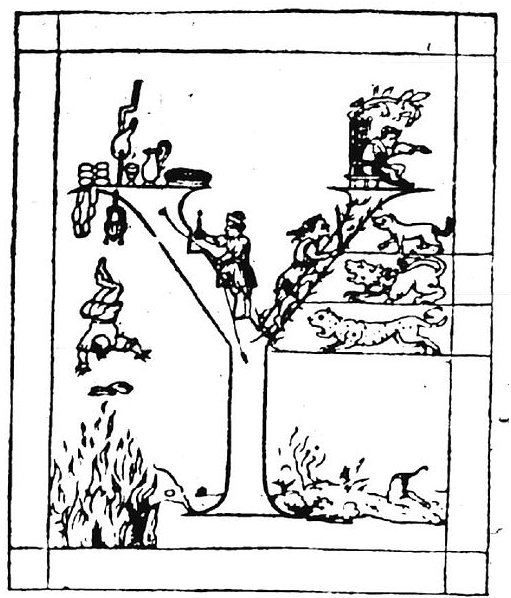 |
|
Sumerian SAG |
 |
Phoenician resh |
 |
Greek rho |
Ρ (ρ) |
|
...
Resh (Arabic: rāۥ)
is the twentieth letter of many Semitic
alphabets, including Phoenician,
Aramaic, Hebrew ... The word resh
is usually assumed to have come from a
pictogram of a head, ultimately
reflecting Proto-Semitic *raۥ(i)š-.
The word's East Semitic cognate, rēš-,
was one possible phonetic reading of the
Sumerian cuneiform sign for 'head' (SAG).

.jpg)
... Then I become aware of ... a presence -
a faint, ghostly glimmering, like moonglow,
that has appeared on the solstice stone. I
don't know how long it lasts, a second or
two only I would guess, but while it is
there it seems less like a projection -
which I know it to be - than something
immanent within the stone itself. And it
seems to function as a herald for it fades
almost as soon as it has appeared and in its
place the full effect snaps on -
instantaneously. It wasn't there, and then
it's there. As Chris had described, the
effect does curiously resemble a poleaxe, or
a flag on a pole, and consists of a 'shaft',
narrow at the base but widening a little
towards the top, running up the left hand
side of the solstice stone, surmounted by a
right-facing 'head' or 'flag'. An instant
later an almond-shaped spot of light, like
an eye, appears a few centimeters to the
right of the 'flag' and the effect is
complete. Weirdly - I do not claim it has
any significance - this flag-on-a-pole
symbol is the ancient Egyptian hieroglyph
neter, meaning 'god', or 'a god' - and
not to be understood at all in the
Judaeo-Christian usage of that word but
rather as a reference to one of the
supernatural powers or principles that guide
and balance the universe. Manifested here,
in this strange Stone Age temple, it glows,
as though lit by inner fire
...

Marija Gimbutas: 'To sleep within the
Goddess's womb was to die and to come to
life anew'. In a system of reincarnation the
old one must die in order to be reborn, of
course. At midsummer Sun comes to a
standstill, and this must therefore be an
occasion when the 'flame of life' had to be
transported into a new body. |
|
Egyptian djed |
 |
Phoenician
sāmekh |
 |
Greek
xi |
Ξ (ξ) |
|
... In
rongorongo times the last Greek lettered
star in
Orion (ξ)
rose with the Sun in June 21. The letter
seems to have originated from the
Phoenician letter samekh (tent
peg, supporting prop), which in turn may
have been derived from the ancient
Egyptian djed column ...
 |
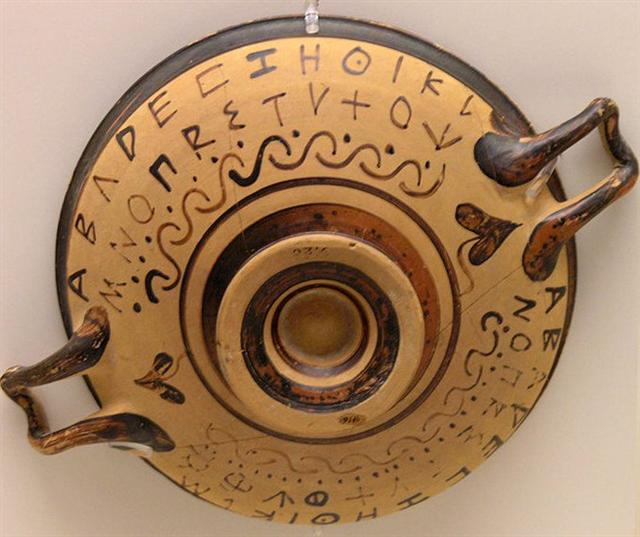
|
Egyptian sticks |
 |
Phoenician
taw |
 |
Greek chi |
Χ (χ) |
|
Greek tau |
Τ (τ) |
|
In
Plato's Timaeus, it is explained that
the two bands that form the soul of the
world cross each other like the letter
Χ.

Roman XII =
12 → XIII = 13, with the Nose in between -
and later, after the Mouth, the cycle would
begin anew (I).
Chi or X is often used to abbreviate
the name Christ, as in the holiday
Christmas (Xmas). When fused within a
single typespace with the Greek letter
Rho, it is called the labarum and used
to represent the person of Jesus Christ.
(Wikipedia)

... tau is
the 19th letter of the Greek
alphabet. In the system of Greek
numerals it has a value of 300
... Taw is believed to be
derived from the Egyptian
hieroglyph meaning 'mark' ...
Taw,
Tav or Taf is the
twenty-second and last letter in
many Semitic abjads ... In
gematria Tav represents
the number 400, the largest
single number that can be
represented without using the
Sophit forms ...
'From Aleph
to Taf' describes
something from beginning to end;
the Hebrew equivalent of the
English 'From A to Z' ...
Tav is the
last letter of the Hebrew word
emet, which means truth.
The midrash explains that
emet is made up of the
first, middle, and last letters
of the Hebrew alphabet (Aleph,
Mem, and Tav...).
Sheqer (falsehood), on
the other hand, is made up of
the 19th, 20th, and 21st (and
penultimate) letters.
Thus, truth is
all-encompassing, while
falsehood is narrow and
deceiving. In Jewish mythology
it was the word emet that
was carved into the head of the
Golem which ultimately
gave it life. But when the
letter 'aleph' was erased from
the Golem's forehead,
what was left was 'met' -
dead. And so the Golem
died ... (Wikipedia)

|
|